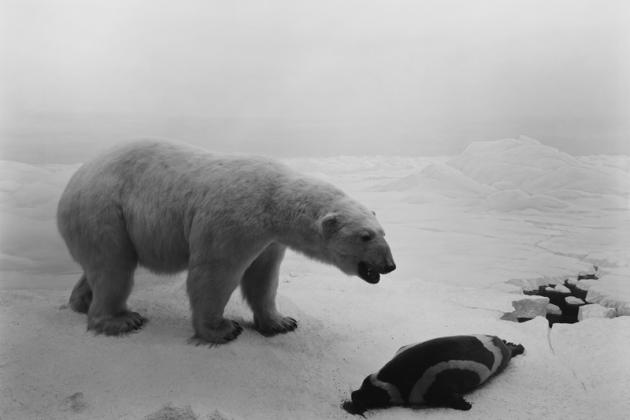Pace Gallery London presents ‘Hiroshi Sugimoto: Still Life’, an exhibition comprised of thirteen large-format photographs from the artist’s ongoing Diorama series created between 1976 and 2012. Sugimoto’s photographs initially appear to be documentary photographs of the natural world, but with a certain exposure that leave the works with a strangely painterly feel – something is not quite right with these beautiful natural vistas.
Hiroshi Sugimoto was born in 1948, Tokyo, and studied at St. Paul’s University, Tokyo, and Art Centre College of Design, Pasadena, California. The artist has lived and worked in New York since 1974. Sugimoto is a conceptual artist who has worked in many forms of media, and was influenced by Minimalism and Conceptual art; the artist also has a lifelong connection to the work and philosophy of Marcel Duchamp.
Central to Sugimoto’s work with a camera is the idea that photography is a ‘time machine’, a method of preserving and picturing memory and time. This theme provides the defining principle for many of his ongoing series, including Dioramas (1976 to the present), Theatres (1978 to the present) and Seascapes (1980 to the present). In his photography, Sugimoto pays meticulous attention to the nuances of silver-print making and its potential for tonal richness, and – in this case – its ability to manipulate perception. The artist’s works have a quality akin to Dutch old master still lives; but with an all-pervading stillness that causes the viewer to question the image.
In fact the artist’s large-scale dioramas are not captured in the wild landscapes of the tundra – or for the matter any other natural environment – but within the constructs of natural history museums. Sugimoto is actually documenting displays of stuffed animals in their simulated environments, but the artist does it with a meticulous calculation, and intention. The works are composed in crisp black and white and sharp tones, the pristine quality and stillness of these large-scale pieces defer the works artificiality of these constructed ‘natural worlds’. Sugimoto’s works are not capturing a freeze-framed moment from the natural world; the animals in the images are already frozen, literally on display. The artist’s ‘time machine’ appears to capture a fleeting moment; yet the work actually perpetuates a frozen moment, forever locked. Sugimoto’s photographs in the oeuvre are ‘still lives of still lives’.
The exhibition surveys the artist’s lengthy series of works and also highlights themes that run through the works over a forty year period. Sugimoto treats his subjects as fossils in time and space. These works are crystallised moments – the images will continue simultaneously as still lives of a lie; and a document of an ‘installation’ – a fantasy of a fantasy – long after the ‘deconstruction’ of the displays.
Sugimoto’s process echoes the principle of time in the works, capturing these frozen scenes on his large-format camera with specific lighting and extended exposures, which have lasted as long as twenty minutes. The exhibition documents the evolution of temporal themes, beginning with Polar Bear (1976), the artist’s first photograph from the series. Sugimoto returned to the American Museum of Natural History in New York where the project began decades previously, with his work from 2012. The piece reveals a heightened influence of landscape, envisioning the world as it was before animal life, and how the world will be after its demise.
Sugimoto’s oeuvre highlights the concepts of memory and preservation. The concept of time and history is in fact mediated through the subject of the museum display. Since beginning this series, the notion of photograph as conceit, through the subversion of historical fact, has also remained an important concept for Sugimoto and permeates the work.
The artist’s Diorama series is a synthesis of the hyper-real: it not only simulates a simulation, but highlights the potential for the convoluted layering of artifice in the contemporary image. The works form a conceptually closed loop; the photographs reside in a never-ending cyclical stillness. Time comes to a halt. Life is absent; aside from the presence of the artist’s eye surveying the stillness and capturing it for the viewer. The frame of the photographs mirror and re-inforces the ‘un-nature’ [as Sugimoto would describe it] of the vitrine enclosed museum displays.
The viewer is left with the beauty of a ‘fiction’ – instead of the beauty of the reality that the museum displays were originally conceived from. In this work – pushed yet another step away from reality, the manipulation of a simulation – hyper-reality is all – Sugimoto’s truly beautiful images contradict, and re-enforce the artifice of the initial object and idea, the result is the ultimate ‘still-life’- the ‘reproduction of a reproduction’ that enforces the beauty of the genuine ‘original’ – life – and quietly laments its passing.
Hiroshi Sugimoto: Still Life – Pace Gallery Burlington Gardens, London – until 24 January 2015
Words: Paul Black Photo: courtesy of the Pace Gallery © Artlyst 2014 all rights reserved

